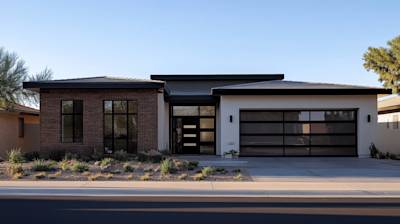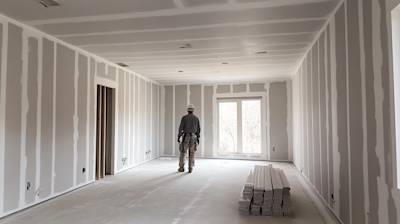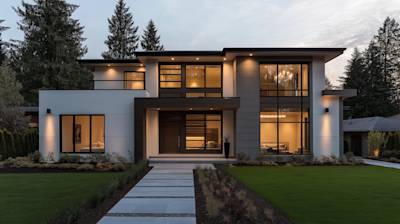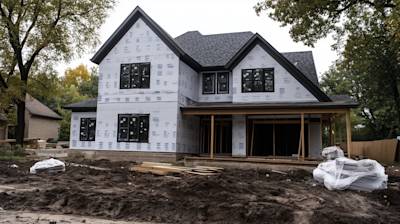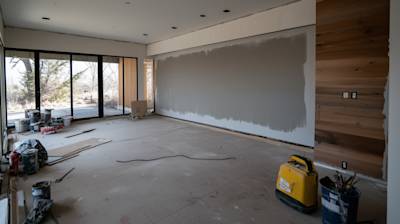In many modern homes today, designers and homeowners are choosing skip trowel texture for their walls and ceilings. Skip trowel texture provides a unique aesthetic that enhances the visual appeal of a space. But what exactly is skip trowel texture and how is it applied? In this blog post, we will delve deep into the intricacies and nuances of this popular finish to help you better understand whether it's the right choice for your home or project.
What is Skip Trowel Texture?
Skip trowel texture refers to a method of adding a unique finish to a wall or ceiling through an application procedure involving a trowel and texture mixture. The term "skip" comes from the fact that areas are left un-textured, achieving a "skipped" effect, that provides dimension and an unusual visual appeal.
The Popularity of Skip Trowel Texture
The popularity of skip trowel texture has surged in recent years due to a number of reasons. Its subtle, elegant appearance and its ability to hide flaws and imperfections are some of its most attractive features. Furthermore, it adds a touch of customization to your home or property since it holds a unique design on every application.
The Process of Applying Skip Trowel Texture
Materials Needed
Applying skip trowel texture involves the use of specific tools and materials. Some of these include:
- A trowel - this spreads the texture mix onto the walls and ceiling
- Texture mix - This is a special mix that can be either bought pre-mixed or mixed onsite
- Protective sheets - These are necessary to cover your floors and protect it from the texture mix
- Paint mixer - To mix the texture if you're doing it on-site
Preparing and Applying Skip Trowel Texture
Preparation is essential to applying skip trowel texture. All the essentials listed above must be prepared before the process begins.
First, the texture mix is prepared. This involves mixing the texture compound until it achieves a thick consistency similar to that of pancake batter. After preparing the mixture, it's now time for application.
Applying skip trowel texture begins by wetting the texturing trowel and scooping up the texture mixture. The loaded trowel is then skimmed lightly onto the wall or ceiling, creating thin layers. Care is taken to leave some areas without texture to achieve the distinctive skip pattern. This process is repeated until the entire wall or ceiling is covered.
Caring for Skip Troweled Surfaces
Caring for skip trowel texture is relatively easy. Cleaning simply involves wiping it with a soft, damp cloth. Avoid scrubbing it vigorously as this might damage the texture. Painting, on the other hand, can be done using a thick-nap roller. The thick nap allows the paint to reach the creeks and crevices of the texture, providing an even coat of paint.
Skip trowel texture is an increasingly popular choice for those seeking to add a touch of elegance and sophistication to their homes or projects. With a bit of practice, it's a technique that can be easily mastered, adding value to your property for years to come.
Remember, for any major project involving wall or ceiling texturing, it's best to consult with a professional in order to get the desired result. A seasoned professional can guide you through the process, ensuring that your walls and ceilings get the aesthetic boost they deserve.
Frequently Asked Questions about Skip Trowel Texture
What kind of aesthetic does skip trowel texture provide?
Skip trowel texture is known for its sophisticated and artistic appeal. It adds depth and character to the walls by creating a unique, hand-applied pattern. The texture is commonly seen in high-end homes and offers an elegant alternative to simple flat or painted walls.
How does skip trowel texture compare to other drywall textures?
Compared to other types of drywall textures like knockdown or orange peel, skip trowel has a more distinctive and unique look. This technique allows the artist to present their skill and craftsmanship. It is usually preferred in upscale locations, while other techniques might be more suitable for regular homes or commercial buildings.
Can I apply skip trowel texture myself?
Yes, skip trowel texture can be a DIY project. However, bear in mind that it is a bit more complex than other textures and requires skill to achieve the desired look. You will need the correct tools and materials, aside from patience and ideally some practice on scrap drywall first.
What tools do I need to apply skip trowel texture?
Applying skip trowel texture requires a few specific tools. The most important of these is a trowel, preferably a curved drywall trowel. You will also need drywall mud, a mud pan, and possibly a mixing paddle and drill for preparing the mud. A drop cloth and masking tape will also be useful to protect your floor and fixtures.
How long does it take for skip trowel texture to dry?
The drying time for skip trowel texture can vary based on the thickness of the application and the conditions in the room. Typically, it can take anywhere from 24 to 48 hours to dry completely. It’s essential to allow the texture enough time to dry before priming and painting.
Can I paint over skip trowel texture?
Yes, after the skip trowel texture has thoroughly dried, you can paint over it. The texture creates a unique pattern that can be highlighted beautifully with paint. However, due to the nature of the texture, you may require more paint than usual to cover all the nooks and crevices.
How do I repair a wall with skip trowel texture?
Repairing a wall with skip trowel texture can be a bit of a challenge due to its unique texture. Ideally, you should scrape away the damaged area, apply a new layer of drywall mud and re-texture it to match the existing pattern. It may require a bit of practice to recreate the specific pattern of your walls.
Are there any specific maintenance tips for walls with skip trowel texture?
Just like any painted wall, walls with skip trowel texture can be easily cleaned using a damp cloth or sponge. If any damage occurs, it's best to repair it promptly to keep your walls looking their best. However, no specific maintenance is required beyond what's needed for regular painted walls.
Pros of Skip Trowel Texture
Unique Aesthetic Appeal
Skip trowel texture can create a unique look and feel in any room. This type of wall finish can blend seamlessly with various home styles, from traditional to contemporary ones. It is a common choice for homeowners seeking a custom, unique look to their rooms as distinct spiral patterns are easy to create with a skip trowel tool.
Versatility
Skip trowel texture brings a great deal of versatility. This design is not confined to walls alone. It is also appropriate for ceilings, adding a new dynamic to the space by significantly enriching its aesthetic appeal. Some homeowners may even use this texture throughout their living room and kitchen to lend continuity to the design.
Easy Repair and Maintenance
Skip trowel texture is relatively easy to repair when damaged. Homeowners can simply mix the compound, apply it to the damaged area, and recreate the texture. This method is more straightforward than other types of texturing techniques. In terms of cleaning, a Home Depot sourced paint roller can easily reach into the crevices.
Sound Absorption
This texture does a remarkable job of absorbing sound. Skip trowel textured walls can contribute to a quieter and more serene living environment by reducing noise transmission.
Durable
Skip trowel texture is known for its robust and durable finish. Once applied, it ideally should not chip or peel, thereby ensuring longevity.
Cons of Skip Trowel Texture
Costly and Time-Consuming to Install
The installation isn't for the faint-hearted. It requires specific tools and a keen eye for detail, making the process fairly complex for beginners, and it can increase the total costs of your house remodeling project.
Production of Dust and Debris
The creation of a skip trowel texture involves scraping away at the drywall, which can produce a significant amount of dust and debris. This can create a mess in the work area.
Difficult to Paint
The uneven, rugged surface of a skip trowel texture can be difficult to paint over. The rough texture tends to soak up more paint, meaning you could end up using more paint than originally anticipated. You might need to use a special type of paintbrush or roller for a proper finish.
Not Suitable for All Styles
While versatile, skip trowel texture may not be suitable for all home styles. For instance, ultra-modern or minimalist styles may not benefit from this texture due to its rough and uneven character.
Can Collect Dust and Allergens
The rough surface of walls with skip trowel texture can also be a magnet for dust and allergens, which can cause problems for people with allergies or respiratory issues.
Listed Pros and Cons for Skip Trowel Texture:
Pros:
- Unique aesthetic appeal
- Great versatility in decoration
- Easy to repair and maintain
- Effective sound absorption
- Durable
Cons:
- Time-consuming and costly to install
- Creates lots of dust and debris during installation
- Challenging to paint
- May not suit all home styles
- Can collect dust and allergens
In conclusion, skip trowel texture contributes unique aesthetic values to homes, but homeowners must consider whether these benefits outweigh the potential downsides such as installation cost and dust collection. As always, it's best to consult with a qualified professional before making any significant changes to your home. Come and explore more such tips and tricks at HGTV.
Summary
So, no matter whether it's a new construction or a remodeling project, skip trowel texture can always give that added push to the aesthetics. It's a coating technique that's not just durable but also very appealing to the eye. If done correctly, it can make a statement in any room. Yet, it requires a certain skill level to achieve, making it a great choice if you're looking for something unique and bespoke.
It's also important to note that skip trowel texture doesn't only look good, but it's incredibly functional. It's capable of masking wall imperfections, discipline the surface architecture, and adding an extra layer of protection to the drywall. So, when you're thinking of interior décor or design aspects that serve a dual purpose, skip trowel texture should definitely be on your list.
But remember, while applying skip trowel texture might just be the touch of elegance your space needs, it's important to understand that it’s not a do-it-yourself task for everyone. It requires a professional touch if you want a clean and classy finish. Therefore, before you plunge into this, make sure you have the right professional help to ensure your skip trowel texture enhances your space, rather than diminishes its beauty.
About Atlas Stucco
Welcome to Atlas Stucco, your go-to stucco company based in Sacramento, CA! We take great pride in our extensive experience and a long-standing reputation for excellent craftsmanship and customer service. Whether it's a simple stucco repair or a full exterior stucco makeover, we are dedicated to providing the highest quality work. Our professional team of expert stucco contractors are committed to exceeding your expectations and transforming your home or commercial property. With Atlas Stucco, prepare to fall in love with the durability and beauty stucco adds to your spaces!
Tags: Skip Trowel Texture, Wall Texture, Home Improvement,



